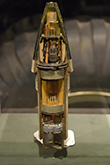Proximity Fuze
A proximity fuze is a fuze that detonates an explosive device automatically when the distance to the target becomes smaller than a predetermined value. Proximity fuzes are designed for targets such as planes, missiles, ships at sea, and ground forces. They provide a more sophisticated trigger mechanism than the common contact fuze or timed fuze. It is estimated that it increases the lethality by 5 to 10 times, compared to these other fuzes.
 British military researchers Sir Samuel Curran and W. A. S. Butement invented a proximity fuze in the early stages of World War II under the name VT, an acronym of "Variable Time fuze". The system was a small, short range, Doppler radar. However, Britain lacked the capacity to develop the fuze, so the design was shown to the United States during the Tizard Mission in late 1940. The fuze needed to be miniaturized, survive the high acceleration of cannon launch, and be reliable.
British military researchers Sir Samuel Curran and W. A. S. Butement invented a proximity fuze in the early stages of World War II under the name VT, an acronym of "Variable Time fuze". The system was a small, short range, Doppler radar. However, Britain lacked the capacity to develop the fuze, so the design was shown to the United States during the Tizard Mission in late 1940. The fuze needed to be miniaturized, survive the high acceleration of cannon launch, and be reliable.
The National Defense Research Committee pulled in researchers from the National Bureau of Standards to work on proximity fuzes for US Army ordnance, with focus on non-rotating projectiles such as bombs, mortars, and rockets. In 1942, the US Army developed its own version of the proximity fuze in an effort spearheaded by Harry Diamond while serving as Chief of the Ordnance Development Division. Much of the basic technology implemented in the proximity fuze used in World War II was inspired by the version created by Diamond’s group. Development was completed under the direction of physicist Merle A. Tuve at The Johns Hopkins University Applied Physics Lab (APL). Over 2,000 American companies were mobilized to build some 20 million shell fuzes.
The proximity fuze was one of the most important technological innovations of World War II. It was so important that it was a secret guarded to a similar level as the atom bomb project or D-Day invasion. More details
 British military researchers Sir Samuel Curran and W. A. S. Butement invented a proximity fuze in the early stages of World War II under the name VT, an acronym of "Variable Time fuze". The system was a small, short range, Doppler radar. However, Britain lacked the capacity to develop the fuze, so the design was shown to the United States during the Tizard Mission in late 1940. The fuze needed to be miniaturized, survive the high acceleration of cannon launch, and be reliable.
British military researchers Sir Samuel Curran and W. A. S. Butement invented a proximity fuze in the early stages of World War II under the name VT, an acronym of "Variable Time fuze". The system was a small, short range, Doppler radar. However, Britain lacked the capacity to develop the fuze, so the design was shown to the United States during the Tizard Mission in late 1940. The fuze needed to be miniaturized, survive the high acceleration of cannon launch, and be reliable.The National Defense Research Committee pulled in researchers from the National Bureau of Standards to work on proximity fuzes for US Army ordnance, with focus on non-rotating projectiles such as bombs, mortars, and rockets. In 1942, the US Army developed its own version of the proximity fuze in an effort spearheaded by Harry Diamond while serving as Chief of the Ordnance Development Division. Much of the basic technology implemented in the proximity fuze used in World War II was inspired by the version created by Diamond’s group. Development was completed under the direction of physicist Merle A. Tuve at The Johns Hopkins University Applied Physics Lab (APL). Over 2,000 American companies were mobilized to build some 20 million shell fuzes.
The proximity fuze was one of the most important technological innovations of World War II. It was so important that it was a secret guarded to a similar level as the atom bomb project or D-Day invasion. More details
